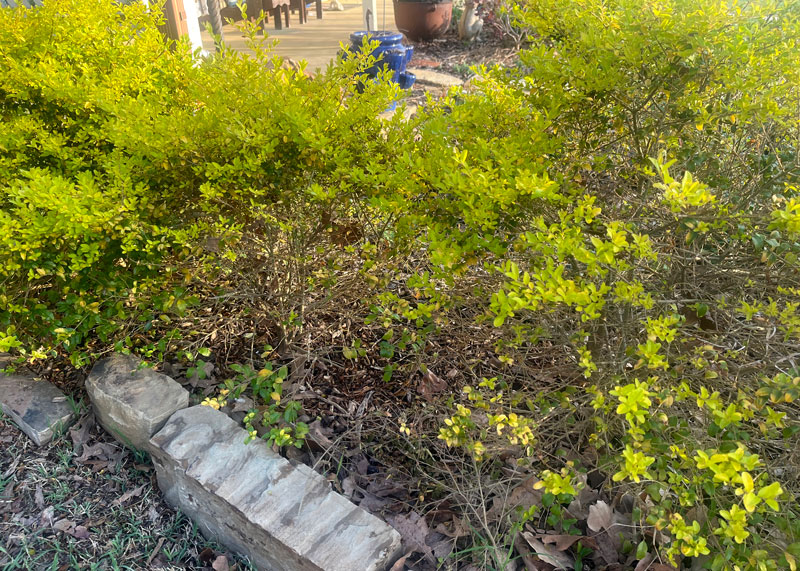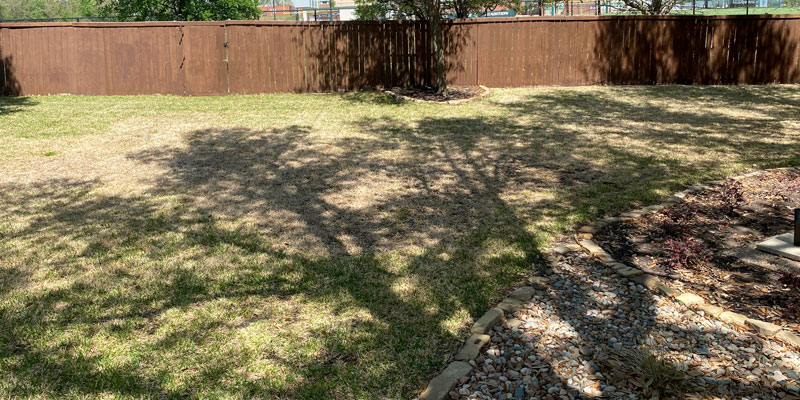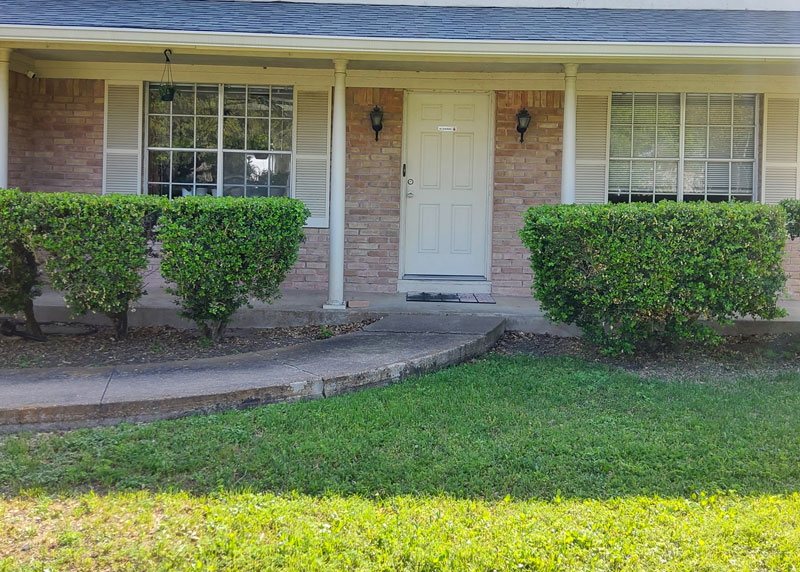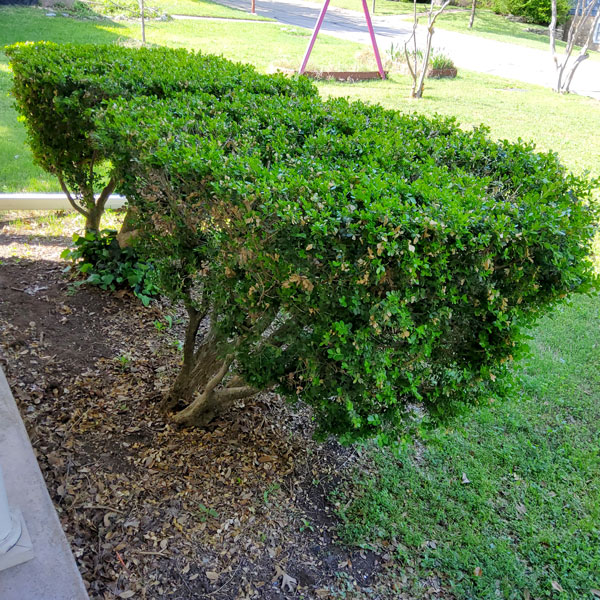Q&A – Ask Neil: April 17, 2025
(Please read these instructions carefully.)
Before you post your question, please look at recent issues to see if someone else has already asked it. You might find your answer there.
How to submit your question…
(Note: You may need to allow a pop-up window to come up in order to get the link for sending your photo(s). If you have already submitted your question and didn’t see the pop-up window, please click here.)
• Click the link provided below to post your question. After you submit your question, a new window will pop up giving you the address to which you can e-mail a SHARP, HIGH-RESOLUTION PHOTO to accompany your question. Please DO NOT SEND THUMBNAIL PHOTOS in case I need to zoom in to see things.
• Click here to post your question.
• Please ONLY POST YOUR QUESTION ONE TIME. We can only accept a set number of questions each week, and when we get duplicates it costs other people their chances.
• One question per reader, please.
• Please use this only for posting questions – not for standard emails.
• Watch for your answer in the following week’s e-gardens.
• I choose those of greatest general interest. For example, plant IDs seldom make the cut.
• I must have your first name or initials.
• I must have your city or county. (Texas is a very large state.)
QUESTION 1
WHY ARE SOME OF MY SUNSHINE LIGUSTRUMS LOSING LEAVES?
Question: Why are some of my Sunshine ligustrums losing leaves? The ones on the left are 4 years old. They have thrived until the past 4 months. Linda L., Grayson County.
Answer: Sunshine ligustrums are odd plants. They don’t hold their variegation very well. It’s not unusual for a planting to end up with a bunch of green plants overtaking the bright yellow growth. Green tissue, after all, grows more strongly and it’s very common for the plants to revert.
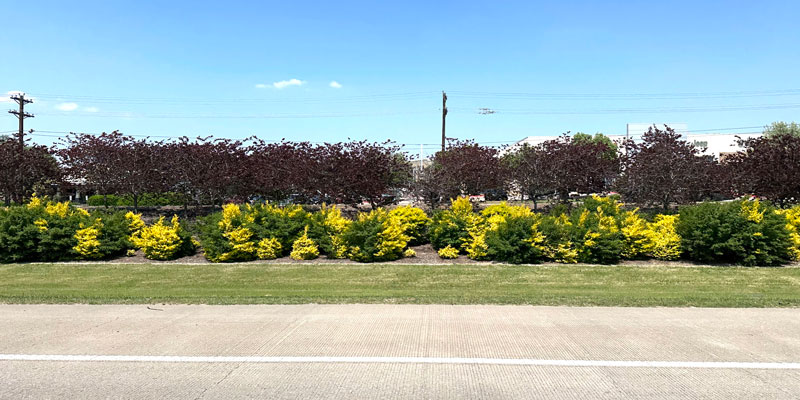
In your plants’ case I’d like to see if there could have been more shade hitting the plant(s) that are losing more of their leaves. It also looks like they might have been pruned several times. That can weaken shrubs after repeated trimmings. The plants put a lot of energy into the new growth, and when it’s trimmed away the plants become somewhat sparse. I would suggest a high-nitrogen fertilizer followed by a deep watering.
QUESTION 2
WHY WOULD AN ESTABLISHED LIVE OAK FALL OVER, ROOTS AND ALL, IN A WINDSTORM?
Question: The windstorm in March caused a neighbor’s large live oak to fall over, roots and all. The same tree survived the May 2024 storm that caused far more damage in our area. Why would an established tree fall like that? Any way to help prevent it? Susan S., Irving.
Answer: Without a photo it’s going to be impossible to tell. It might have been difficult even with a photo. It could be that last year’s storm weakened the tree enough that this year’s weather finished the work. It could also have deteriorated in the past 12 months due to damage done a year ago. Or the wind might have been out of a slightly different direction. If there are other trees in the neighborhood that you fear might be in jeopardy, why don’t you hire a certified arborist as a neighborhood to check all your trees out. You could find out if it was just an isolated incident involving the one tree.
QUESTION 3
WHY DOES MY ST. AUGUSTINE HAVE LARGE BROWN AREAS?
Question: My wife and I just purchased a house last August. It has St. Augustine grass, and the large brown areas are confusing me. What do I need to do? Paul S., Southlake.
Answer: It looks like the St. Augustine was dense and healthy last year, perhaps as recently as late summer. When large areas fail to green up in the spring, I consider several possibilities. I’ll give you my best guesses.
• Take all root rot fungus is present when the grass is yellowed and lethargic in the spring, right alongside sweeps of normal grass. I do not see that at all in your photos, but this is the time of year that it would be happening. The grass runners would pull loose easily from the soil and the very short roots would be almost black and rotted.
• White grub worm damage shows as dead turf that pulls loose easily from the soil, runners and all. That’s because the grubs have devoured all the roots. Give the grass a yank. I don’t think that’s what you’ll find, but you can easily enough dig to see if there are 5 or 6 grubs per square foot – the threshold number for killing the grass.
• Left over impact of brown patch fungus from fall. It turns 30-inch patches of grass brown in November. The blades turn yellow first, then brown. They can easily be pulled loose from the runners. The runners remain attached to the soil. The roots are not impacted.
• Left over damage of chinch bugs from last summer. This would be my guess if the grass just does not green up at all. They show up in larger areas, always in full sun only. Grass appears dry. We water, but it doesn’t help. People say, “My lawn burned up.” In reality, the chinch bugs sucked all the moisture out of the plants. They kill all the grass in patches ranging from a few to many feet in diameter.
Controls: The insecticide Imidacloprid will control chinch bugs and white grub worms, although the grub treatment is preventive and made in late June. The fungicide Azoxystrobin will stop TARR, gray leaf spot (summer disease problem), and brown patch.
QUESTION 4
SHOULD I COVER THE MANY ROOTS OF MY LITTLE GEM MAGNOLIA?
Question: Should I cover the roots of my Little Gem southern magnolia on the side of our house? It has many roots above ground, luckily in a flowerbed. Should I leave them alone or cover them with potting soil or mulch? The tree is doing really well. It is taller than our house. Cindy P., San Antonio.
Answer: Leave them alone. Surface roots are normal for many trees, especially when they are grown in areas with shallow soils. As the roots grow larger, they extend above the soil’s surface, even to the point of becoming hazards when they’re in turf areas where people walk. They also can be a threat to sidewalks, curbs and even foundations. It sounds like your tree may be very close to your house. If that’s the case, you should monitor the major roots to be sure they don’t grow large enough to pry against the slab. Tree roots extend far beneath houses because of moisture that is usually available there. You may want to have a certified arborist keep an eye on it for you. If they are unsightly in any way, you could conceal them with a tall evergreen groundcover. Coarse mulch would also be permissible but be careful that you don’t cover weep holes in the masonry side walls of your house.
QUESTION 5
WHAT SHOULD WE DO WITH THESE BOXWOODS?
Question: These boxwoods were here when I purchased the house in 1990. (It was built in 1968.) They are growing outward instead of upward. They usually look better, but we had just trimmed them when I took the photo. Is there a better evergreen for this location? Debbie H., Austin.
Answer: You’ve gotten 35 years (or more) of good out of them. That’s more years than we get out of most furniture inside our homes. It’s probably time to remodel this part of your landscape, and I’d start by removing the boxwoods. There is no rule that says you are required to use the same plant on both sides of your front walk. You could use dwarf yaupon hollies within the area enclosed by the walk. It resembles boxwood but is a bit more spreading. It does not have thorns, so it would be passerby friendly.
Dwarf Burford hollies would be slightly taller, and they could be used to the right side in the one photo. You could anchor the shrubs to the ground with an attractive groundcover, and you could position three large, glazed pots in which you feature seasonal color near the entryway. That would all be very simple landscaping, but it could be effective. Of, if you get a professional designer on the job with you, something more intricate could unfold. Either way, this ought to be the year that you make something nice happen.
As a final note to my reply: As I finished cropping and editing your photo one other thing also stood out. The front edge of your walk is really stark. I would extend the new bed to be in front of the walk! Let it sweep across the entire front 2-3 feet away from the walk. Build it up with enough soil that your very low shrubs and/or groundcover can conceal that vertical masonry surface. The walk would go through the landscape bed to your porch and not beside it. It could look really pretty.
QUESTION 6
ARE HIGH-FREQUENCY DEVICES EFFECTIVE IN DETERRING SQUIRRELS FROM OUR YARD?
Question: I know this is different from the questions you normally get. Would the high-frequency devices be effective in deterring squirrels from our yard? Randy L., Dallas County.
Answer: You’ve heard the words, “There are 30 minutes of my life I’ll never get back!” I just spent half an hour combing through the results of a Web search using key words “university ultra-sonic squirrel deterring devices.” I truly did try to help you! I found reading to last a lifetime, almost all of it not from university websites and almost all of it from the same fake consumer rating services, post after post. They all had glowing comments that all looked shaky to my eyes. Just like the claims that are made for the miracle soil additives that are sold in Texas and a few other states.
From all I have heard and read, these things are poor investments – not one that I’d ever want someone to confuse as my having recommended. I would suggest you look to university wildlife management specialists for information on keeping squirrels away from where you don’t want them.
QUESTION 7
WHAT HAPPENED TO MY RED OAK? WILL IT SURVIVE?
Question: Our red oak is a year-and-a-half old. It has damage at its base (unsure of the cause). It’s been staked since planting. Do you think it will survive? Should I wrap it? It seems to be leafing out as usual. Kimberly R., Sanger.
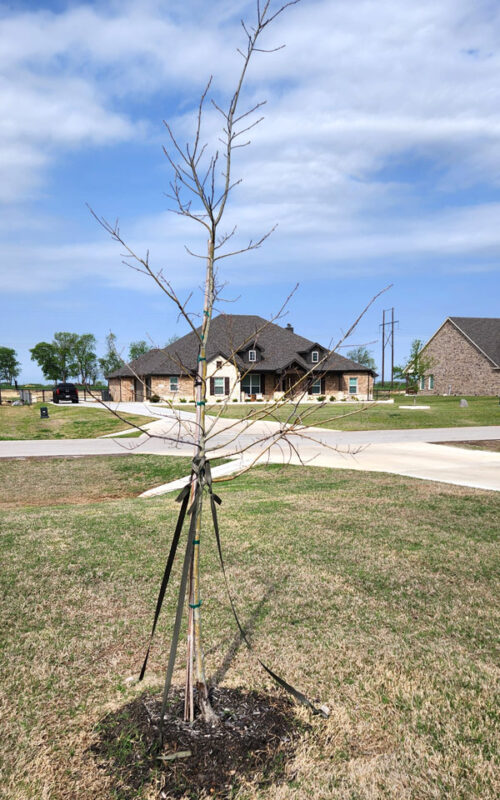
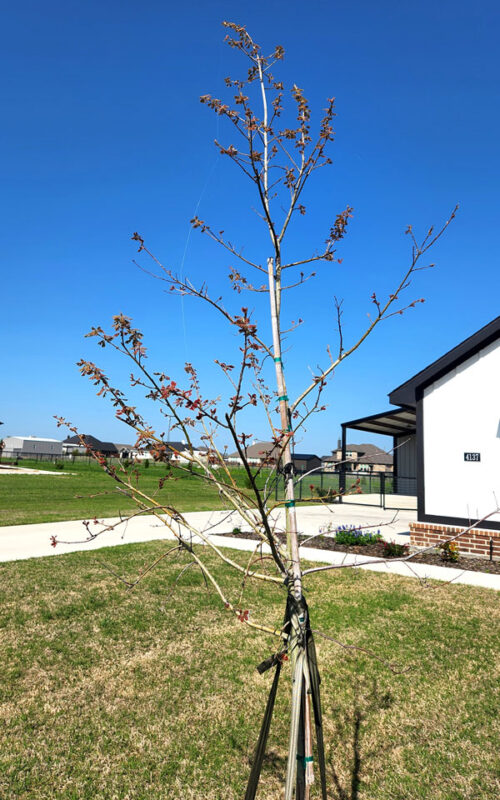

Answer: If you’ve watched this part of e-gardens very long you’ve seen others post questions about their red oaks and red maples and the bark loss that they are experiencing.
Your tree, like theirs, is suffering from sun scald. It was grown in a nursery in its younger years, and one tree shaded the next. Then it was moved out into the sun all by itself. My bet is that this cracked bark is on the west or southwest side of the trunk where the intense summer sun baked it. (I’ve never seen it happen on the north side where the sun doesn’t hit the trees’ trunks.) The bark overheats, then cracks, and starts to peel off. Then the internal tissues start to dry and decay.
You say that your tree is leafing out as normal, but if you look closely at the more distant photos, you’ll see that one side isn’t leafing out very well. I’ll bet that’s directly above this bark-less, decaying portion of the trunk.
Will the tree survive? Yes. It’s already putting out new growth from its base. That tells you that the top growth is in great distress. Otherwise, those buds would remain dormant. So, worst case, it will resprout from the ground up and you’ll get to start with new trunks once you cut off the old, dying trunk. Or you can wait several years and see if it can heal itself, but it will be much weaker for the problems it’s going through. If it were mine, I’d replace it.
One other tip: Next time you stake a tree, use sturdier stakes. Place them farther away from the trunk so they will have more strength because of their angles. And, keep the straps taut at all times so they can’t whip and snap.
QUESTION 8
WHAT KIND OF ZINC SHOULD I APPLY TO MY PECAN TREE? WHEN? WHAT FERTILIZER? WHEN?
Question: I understand I need to spray zinc on my pecan tree. When should I do that, and what kind of zinc should I use? When should I fertilize the tree, and with what material? Pat., College Station.
Answer: (Pat called my statewide radio program Saturday morning. I told him I would prefer to do a little homework to be sure I had the most current A&M recommendations on this, and that I would post my reply here. He is already a subscriber, so he’ll be watching for his answer, as will my other listeners.
My online sources of information are:
Commercial Pecan Orchards in Texas by Drs. George Ray McEachern, Larry Stein, and Julian Sauls
and
Native Pecans by Drs. Larry Stein, Monte Nesbitt, and Jim Kamas
The Commercial Pecan Orchards bulletin recommends either liquid zinc nitrate or granular zinc sulfate, saying that sprays of either are essential for pecan growth in Texas. They continue that “Soil or irrigation applications of zinc are not effective.”
The sprays, they tell us, need to be made at bud break and one week apart for three weeks. The 4th application is made two weeks later and the 5th application three weeks after that. Zinc sprays should not be allowed to drift onto fruit crops, vegetables, flowers, and landscape plants. Zinc can burn their foliage, so apply it strictly according to label warnings.

